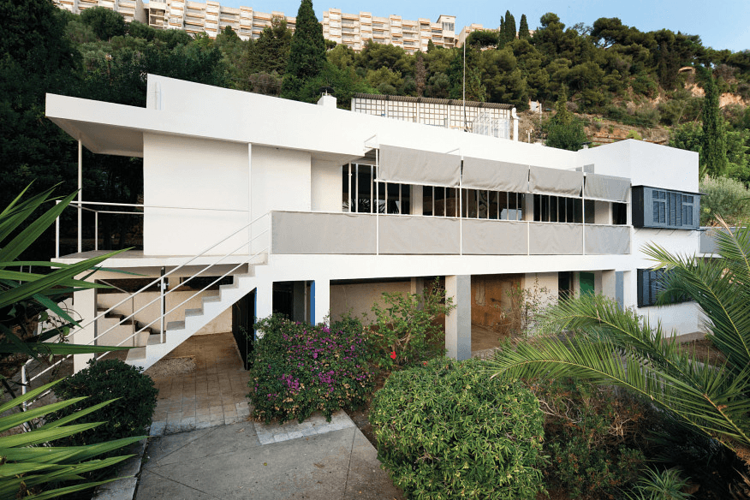We’ve all heard of Le Corbusier, but who is Eileen Gray? As the below article in Architect Magazine attests, she is a wildly under-appreciated midcentury architect and furniture designer an “bisexual daughter of Irish aristocracy.” A contemporary of Le Corbusier, Gray built a modular summer getaway for her lover, to which would later invite Le Corbusier, who in turn vandalized it with drunk “murals.” The site, named E-1027 by Gray, is now preserved after decades of neglect. Read Anthony Flint in Architect Magazine in partial below, or the full version here.
The bisexual daughter of Irish aristocracy, Gray shunned marriage and forged her own way in Paris, designing furniture and objets d’art in the Roaring Twenties. Her lover, the architecture critic and bon-vivant Jean Badovici, asked her to find a spot in the South of France for a summer getaway. Coco Chanel would soon establish her own digs nearby at the luxurious La Pausa estate, but Gray hacked her way through lemon trees and banana palms to a site inaccessible by car. There, on the hillside just southeast of the Roquebrune-Cap-Martin train station, she conjured an all-white pastoral retreat bathed in sunlight, freshened by breezes, and outfitted with sleek yet practical furnishings of leisure.
Indeed, the design of E-1027 seemed to take shape around the furniture and the way its occupants would move in physical space. Gray created built-in cabinets and drawers for summer clothes, guest rooms and nooks that allowed retreat and privacy, little windows positioned to afford spectacular views, deck-chair-style chaise lounges, and reading stands, dining tables, and tea and gramophone trolleys that extended and unfurled like something out of a Jetsons cartoon. The exterior, a rectangular box wedged into the hillside and supported by pillars, was punctuated by a simple cube with horizontal strips of dark shuttered windows.
E-1027—the name is based on where Gray and Badovici’s initials fall in the alphabet (“E” standing for Eileen, “10” for the J in Jean, and so on)—was completed in 1929, when Gray was 51 years old. She schlepped building materials by wheelbarrow, building the place herself with help from a crew of local workers. It was an astonishing accomplishment. But the villa seemed doomed from the start. It was never the romantic destination the couple had first envisioned. She wanted to snuggle; he wanted to party. They split up, and Gray ended up building another house for herself in nearby Menton.
The real trouble started a few years later, when Badovici invited his friend Charles-Édouard Jeanneret to stay at E-1027 with his wife, Yvonne. Le Corbusier, as Jeanneret had rebranded himself, had just earned international fame with the Villa Savoye, and he decompressed from work by lounging around E-1027 in various states of undress. Eventually he decided the white walls needed improvement, and he painted eight racy murals of Picasso-like female figures, some intertwined in sexy repose. Photographs captured the architect, naked in the Riveria heat, with the offending paintbrush in hand.
Gray called it an act of vandalism. Badovici, put in a difficult spot, chastened Le Corbusier and told him he had worn out his welcome. The tension underlying the affair was electric. Here was a modernist summer home so superb Le Corbusier himself could have created it—but built by someone untrained in architecture, and a woman, no less. Gray had also angered Le Corbusier—not hard to do—by quibbling with his dictum that a home was a “machine for living in.” A home, she argued, was actually a living organism.
Caught in the act: Le Corbusier painting on E-1027 drunk in the buff
*Image of restored E-1027 by Manuel Bougot via Architect Magazine

